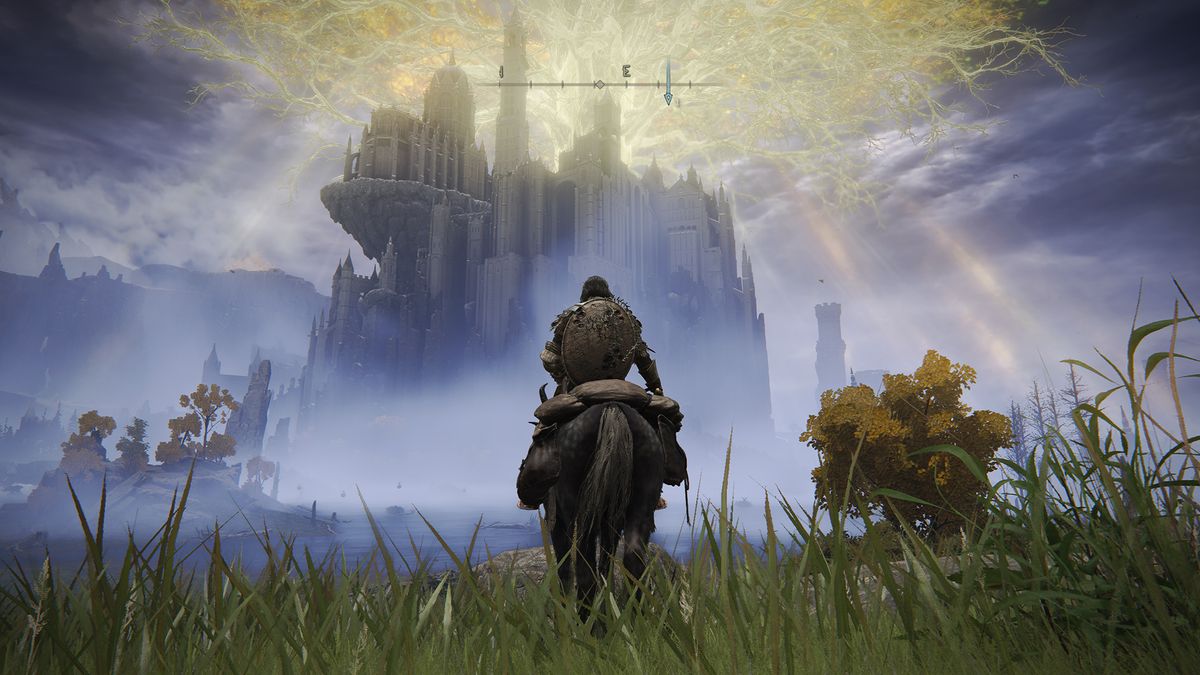Survive the Lands Between with these Elden Ring guides
Elden Ring guide: Conquer the Lands Between
Elden Ring bosses: How to beat them
Elden Ring dungeons: How to defeat them
Elden Ring paintings: Solutions and locations
Elden Ring map fragments: Reveal the world
We could write a novel’s worth of tips for Elden Ring . It’s a huge, difficult game: There are enemies to defeat, characters to speak with, and many, many items to find as you snake through the Lands Between. But knowing every detail of Elden Ring beforehand would ruin some of those precious moments where you stumble into something you didn’t even know the game was capable of.
These tips won’t contain any significant spoilers, but they will still hopefully be able to help you overcome some early hurdles. Don’t assume you need to spend hours grinding runes every time you run into a brutal boss.
If this is your first FromSoftware game, Elden Ring might throw you for a loop early on. It isn’t structured like many other RPGs, and the way you interact with its NPCs and some other elements are definitely not straightforward. The tips below won’t stop you from getting lost—that’s part of the fun—but they will help you find the tools you need to progress.
1. Pick a good starting class
Veteran Souls players will tell you that starting classes don’t matter much. It’s true in a sense: you can build your stats in any direction, so the starting class is just a head start rather than a choice that locks you into a particular role. That’s still true in Elden Ring, but because the game unfolds at a relatively slow pace compared to the much shorter and smaller Souls games before it, your starting class has a big impact on your first dozen or so hours.
Use the explanation option in the menu (E on keyboard or Y on controller by default) to read through the stats and pick one that suits either a melee- or spellcasting-based character. For new Souls players, I’d recommend choosing a class like the Vagabond for their balanced starting stats, or the Hero for their emphasis on Vigor (health) and Strength. If you start the game using a sword and shield and decide early on that you want to use magic, it’s not a big deal, but it might mean you’ll have to leave some enemies or bosses for later until you’ve leveled Intelligence up to meet their difficulty.
If you really don’t like the idea of trading blows with bosses, pick the Astrologer. Using powerful magic spells from a distance can make some fights much easier.
2. Pick up everything
Elden Ring is an open game and, naturally, it has a crafting system. While you gallop through the Lands Between on your mount Torrent, make sure to spam the button you use to pick up items as you pass over bushes and flowers. The world is packed full of herbs to pick, so you don’t need to go out of your way, but you should make it a habit to clean out a path on your way to your destination. That way you can craft useful tools like firebombs, multiplayer summoning items, and arrows.
3. Use stealth
I can’t stress this enough: use the stealth system. Elden Ring’s stealth system seems to be plucked right from Sekiro. Enemies are limited in how far away they can hear you when you’re crouching, and if they do, they only go looking where they last saw you. That means you can abuse the stealth to get you to items that are past a few monsters, or to get yourself in position for a nasty, high damage backstab.
Some parts of the game almost require stealth, too, so practicing it early on will give you a leg up when that time comes.
4. Don’t head for the big castles first
This may sound like a weird tip, considering sticking to the critical path is the easiest way to play many games. But in Elden Ring, don’t go straight to the big castle or buildings planted at the end of every major area. It feels natural to barrel toward something that looks like it’ll move the story forward as soon as possible, but that’s not really how the game is designed. If you want a massive challenge, go for it, but Elden Ring is structured more like an MMO. The open world is for exploring, doing side quests, defeating minibosses, collecting gear, and leveling up. The dungeons, or castles, are more like raids that jump up in difficulty and hold bosses with multiple phases.
You’ll be rewarded for moseying around the overworld for a bit, gathering useful crafting materials for hunting down golden seeds to upgrade your flasks.
5. Prioritize the map fragment icons
Filling in Elden Ring’s map is a great way to start investigating a new location. Even if you’d like to let the game lead you to things organically, it’s nice to make sure you have the map fragment unlocked in case you need exact directions. When you get to a new section of the Lands Between, open the map and look for a stone tablet icon. That will be where the map fragment item is located. They’re usually close to the entrance, but sometimes they take a bit of effort to get to.
Once you have it, it’ll clear out the fog on the map and you’ll be able to see the main roads. You can ignore the map, but if you die and really want those runes back, it’ll be nice to have it around to help you get back to your body.
6. Make sure you don’t have a heavy equip load
As you find new weapons and armor, you may be eager to equip anything with better stats than what you had before. That’s fine, but pay attention to the “equip load” detail on your character status column. Your maximum equip load is dictated by your endurance stat, and Elden Ring helpfully points out whether you’re at a light, medium, or heavy load based on your equipped armor and weapons.
A light or medium load is good: you’ll be able to dodge roll faster and further with more “invincibility frames” than with a heavy load. Avoid a heavy load: it’ll stick you with the infamous “fat roll,” which makes you a slow, prime target for bosses and uses more stamina with each roll. Put more points into endurance if you want to wear heavier armor or wield particularly heavy weapons. The mobility of a lighter roll is almost always more beneficial than the defensive stats you’ll get with heavier armor.
7. Don’t be afraid to come back later
Elden Ring’s non-linear format means you’ll run into bosses or enemies that are way too tough for you right now. In fact, this can happen throughout the game even with bosses located in the same area. Like in a lot of other open world games, you should get used to leaving tough encounters or dungeons for later when you’re a little tougher.
Unlike past Souls games, Elden Ring lets you fast travel to a checkpoint from basically anywhere. I played the game for 60 hours for our Elden Ring review, and there’s still stuff in the early areas that kicks my butt.
8. Help other players beat bosses and dungeons to farm runes
Other players can help you through many challenges in Elden Ring, but if you help them instead, you can earn yourself a bundle of runes risk-free. Use your Tarnished’s Furled Finger item next to a site of grace in a dungeon, or right in front of a boss door, to allow other players to summon you into their game world. While you’re there, you’ll gain runes for every enemy either of you kill, and there’s zero risk: When you die, you’ll just return to your own game, keeping all the runes you collected.
Letting other players summon you is a great way to level up and to scope out dungeons and tough fights “safely” before taking them on in your own game.
9. Make use of Spirit Ashes and NPC summons
The biggest mistake you could make in Elden Ring is skipping out on the Spirit Ashes. After the opening hour, be sure to find the ruins of a church near the first Site of Grace (bonfire) after the tutorial. Go there at night, meet the lady with a big hat and get the Spirit Bell from her. If you can’t find her, head to the game’s hub area, Roundtable Hold, and buy it from the two dead maidens (don’t ask me how this is possible, it’s a FromSoftware game).
Throughout the Lands Between there are bosses and groups of enemies in the open world that are difficult to defeat without really careful play, so it’s often much easier to split their attention with AI allies. Whenever you enter a new area or room, check if you get the grave icon on the bottom left of your screen that enables summons. You can find and unlock all sorts of lethal companions, including skeletons, archers, and wolves. If you do enough exploring, you’ll even be able to upgrade them to do more damage.
Also, always look out for a yellow NPC summon sign near a boss door, particularly in the first dungeon, Stormveil Castle. You need to poke around the courtyard area until you find the character, but once you do, they will help you fight the final boss of the zone. Players can be summoned in the exact same way, but when you select the sign, it’ll say their name. It’s up to you if you want to summon Souldierboy420 instead of an NPC.
10. Try bleed and frost skills against tough enemies
Elden Ring’s gigantic bosses are intimidating just to look at, but even more intimidating is seeing their health bar stretch across your entire screen—and seeing how little of it chips away when you hit them. One way to whack that health off way more quickly is to use weapons that cause bleed. Hit an enemy enough times and you’ll build up an invisible blood loss meter, at which point they’ll lose a major chunk of health. Because bleed damage is percentage based, it can be especially effective against bosses with tons of health.
You’ll find bleed skills innately on katanas, daggers, and some other weapons, but you can also add it to weapons with some Ashes of War.
Frost attacks are also extremely useful: If you build up enough frost on a foe they’ll suffer frostbite, which also deals a percentage of damage and debuffs them, making them take more damage for a time.
11. Learn how to dual wield weapons
If you equip two of the same type of weapon in Elden Ring, your character will enter a “powerstance” that gives you access to a unique attack on the L1 button. Yes, you have to give up a shield, but in return you have the potential to deal some serious damage.
Powerstancing doesn’t require two of the exact same weapon: they just need to be of the same type, like two straight swords or two daggers or two scythes. Equip a matched pair and experiment with the L1 attack animations (don’t forget to try jump attacks) to get a feel for the combo and range. It’s a more aggressive playstyle, but you’re often better off dodging attacks from Elden Ring’s toughest enemies than trying to block them, anyway.
12. Experiment with more Ashes of War
Elden Ring introduces a new form of weapon skills that often use your blue FP resource. Ashes of War are abilities tied to weapons and shields that perform special attacks like holy projectiles, magic deflection, and attack power boosts. They also affect how well your weapon scales with certain stats.
Certain enemies and bosses are weak to specific types of damage, so it’s smart to play around with which Ashes of War you have equipped on each weapon. There’s absolutely no downside: you’re free to swap between different Ashes of War, and they’ll never be consumed or locked to a weapon.
If you’re doing a boss run, give a few different skills a try and see if you can work them into your rotation. Weapons skills aren’t meant to replace normal combat, but they can help you get the edge against a particularly tough boss.


